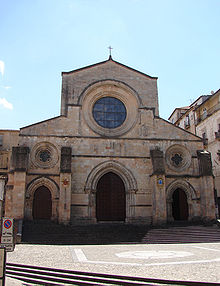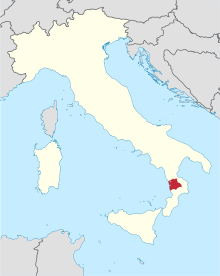Roman Catholic Archdiocese of Cosenza-Bisignano
|
Archdiocese of Cosenza-Bisignano Archidioecesis Cosentinus-Bisinianensis |
|
|---|---|

Cathedral of Cosenza
|
|
| Location | |
| Country | Italy |
| Ecclesiastical province | Cosenza-Bisignano |
| Statistics | |
| Area | 979 sq mi (2,540 km2) |
| Population - Total - Catholics |
(as of 2006) 383,000 381,000 (99.5%) |
| Parishes | 127 |
| Information | |
| Denomination | Roman Catholic |
| Rite | Latin Rite |
| Established | 7th Century |
| Cathedral | Cattedrale di S. Maria Assunta (Cosenza) |
| Co-cathedral | Concattedrale di S. Maria Assunta (Bisignano) |
| Patron saint | Madonna del Pilerio Francesco di Paola Beato Umile da Bisignano |
| Secular priests | 163 |
| Current leadership | |
| Pope | Francis |
| Archbishop | Salvatore Nunnari |
| Suffragans | sees: Cassano all’Jonio Archdiocese of Rossano-Cariati San Marco Argentano-Scalea |
| Emeritus Bishops | Giuseppe Agostino |
| Map | |
 |
|
| Website | |
| diocesicosenza.it | |
The Italian Catholic archdiocese of Cosenza-Bisignano in Calabria has been a metropolitan see since 2001.
The Gospel was first preached in Cosenza by missionaries from Reggio; its earliest known bishop is Palumbus, a correspondent (599) of St. Gregory the Great. Cosenza was erected as a diocese in 700. Cosenza was raised to the dignity of an archbishopric about 1050. Among the best known Archbishops of Cosenza have been: Ruffo, who perished in the earthquake of 1184; the Cistercian Martino (1285), a prolific but uncritical writer; Pirro Caracciolo (1452), the friend of St. Francis of Paula; Bartolommeo Fleury, who died at Rome (1495) in Castle Sant' Angelo, where he had been imprisoned for forgery of pontifical documents; Taddeo, later Cardinal, Gaddi (1535), who obtained from Paul IV the privilege by which the cathedral canons of Cosenza wear the choir habit of the Vatican basilica; and Giuseppe Maria Sanfelice (1650), frequently charged by the Holy See with diplomatic missions.
In 1908, The diocese has a population of 159,500, with 109 parishes, 264 churches and chapels, 200 secular and 16 regular priests, 2 religious houses of men and 5 of women.
On April 4, 1979, the Archdiocese was united with the Diocese of San Marco e Bisignano as Cosenza e Bisignano retaining the former Diocese of Bisignano with remainder renamed as the Diocese of San Marco Argentano-Scalea. On September 30, 1986, the Archdiocese was renamed to Cosenza-Bisignano and was elevated to a Metropolitan See on January 30, 2001.
Erected: 7th Century
Latin Name: Cosentinus
Elevated: 1150
Latin Name: Cosentinus
Immediately Subject to the Holy See
United: 4 April 1979 with the Diocese of San Marco e Bisignano
Latin Name: Cosentinus et Bisinianensis
Name Changed: 30 September 1986
Metropolitan See
![]() This article incorporates text from a publication now in the public domain: Herbermann, Charles, ed. (1913). "". Catholic Encyclopedia. New York: Robert Appleton.
This article incorporates text from a publication now in the public domain: Herbermann, Charles, ed. (1913). "". Catholic Encyclopedia. New York: Robert Appleton.
...
Wikipedia
